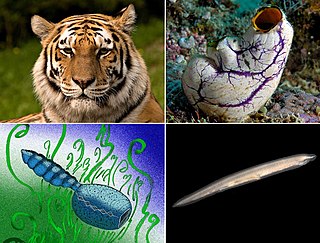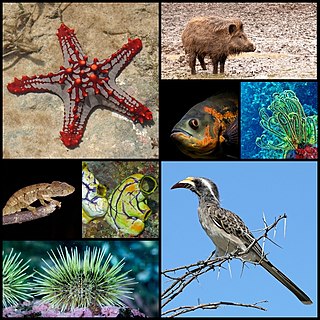Related Research Articles

A chordate is an animal of the phylum Chordata. During some period of their life cycle, chordates possess a notochord, a dorsal nerve cord, pharyngeal slits, and a post-anal tail: these four anatomical features define this phylum. Chordates are also bilaterally symmetric, and have a coelom, metameric segmentation, and circulatory system.

In all bilaterian animals, the mesoderm is one of the three primary germ layers in the very early embryo. The other two layers are the ectoderm and endoderm, with the mesoderm as the middle layer between them.

Hemichordata is a phylum of marine deuterostome animals, generally considered the sister group of the echinoderms. They appear in the Lower or Middle Cambrian and include two main classes: Enteropneusta, and Pterobranchia. A third class, Planctosphaeroidea, is known only from the larva of a single species, Planctosphaera pelagica. The extinct class Graptolithina is closely related to the pterobranchs.

Haikouella is an agnathan chordate from the Lower Cambrian Maotianshan shales of Chengjiang County in Yunnan Province, China.

Sonic hedgehog is a protein that in humans is encoded by the SHH gene. It is the best-studied ligand of the hedgehog signaling pathway others being desert hedgehog (DHH) and Indian hedgehog (IHH). It plays a key role in the development of animals from insects to mammals. In vertebrates it is involved in organogenesis including the growth of digits on limbs and the organization of the brain. Sonic hedgehog is an archetypal example of a morphogen as defined by Lewis Wolpert's French flag model—a molecule that diffuses to form a concentration gradient and has different effects on the cells of the developing embryo depending on its concentration. Sonic hedgehog is also active in adults; for example it controls the proliferation of adult stem cells and has been implicated in the development of some cancers.

A tunicate is a marine invertebrate animal, a member of the subphylum Tunicata. It is part of the Chordata, a phylum which includes all animals with dorsal nerve cords and notochords. The subphylum was at one time called Urochordata, and the term urochordates is still sometimes used for these animals. They are the only chordates that have lost their myomeric segmentation, with the possible exception of the 'seriation of the gill slits'.

In anatomy, the notochord is a flexible rod formed of a material similar to cartilage. If a species has a notochord at any stage of its life cycle, it is, by definition, a chordate. The notochord lies along the anteroposterior axis, is usually closer to the dorsal than the ventral surface of the animal, and is composed of cells derived from the mesoderm.

Larvaceans, Class Appendicularia are solitary, free-swimming tunicates found throughout the world's oceans. Like most tunicates, larvaceans are filter feeders. Unlike most other tunicates, they live in the pelagic zone, specifically in the photic zone, or sometimes deeper. They are transparent planktonic animals, generally less than 1 cm (0.39 in) in body length, excluding the tail.

Ascidiacea, commonly known as the ascidians, tunicates, and sea squirts, is a paraphyletic class in the subphylum Tunicata of sac-like marine invertebrate filter feeders. Ascidians are characterized by a tough outer "tunic" made of the polysaccharide cellulose.

A cephalochordate is an animal in the chordate subphylum, Cephalochordata. They are chordates with all 5 synapomorphies, the characteristics all chordates have during the larval or adulthood stages. These synapomorphies include: notochord, dorsal hollow nerve cord, endostyle, pharynx and post-anal tail. Cephalochordates are represented in modern oceans by the Amphioxiformes.

The lancelets, also known as amphioxi, consist of some 30–35 species of "fish-like" benthic filter feeding chordates in the order Amphioxiformes. They are the modern representatives of the subphylum Cephalochordata. Lancelets closely resemble, and are believed to be related to, 530-million-year-old Pikaia, fossils of which are known from the Burgess Shale. Zoologists are interested in them because they provide evolutionary insight into the origins of vertebrates. Lancelets contain many organs and organ systems that are closely related to those of modern fish, but in more primitive form. Therefore, they provide a number of examples of possible evolutionary exaptation. For example, the gill-slits of lancelets are used for feeding only, and not for respiration. The circulatory system carries food throughout their body, but does not have red blood cells or hemoglobin for transporting oxygen. Lancelet genomes hold clues about the early evolution of vertebrates: by comparing genes from lancelets with the same genes in vertebrates, changes in gene expression, function and number as vertebrates evolved can be discovered. The genome of a few species in the genus Branchiostoma have been sequenced: B. floridae,B. belcheri, B. lanceolatum

Neurulation refers to the folding process in vertebrate embryos, which includes the transformation of the neural plate into the neural tube. The embryo at this stage is termed the neurula.
A germ layer is a primary layer of cells that forms during embryonic development. The three germ layers in vertebrates are particularly pronounced; however, all eumetazoans produce two or three primary germ layers. Some animals, like cnidarians, produce two germ layers making them diploblastic. Other animals such as chordates produce a third layer between these two layers, making them triploblastic. Germ layers eventually give rise to all of an animal’s tissues and organs through the process of organogenesis.

Balanoglossus is an ocean-dwelling acorn worm (Enteropneusta) genus of great zoological interest because, being a Hemichordate, it is an "evolutionary link" between invertebrates and vertebrates. Balanoglossus is a deuterostome, and resembles the Ascidians or sea squirts, in that it possesses branchial openings, or "gill slits". It has notochord in the upper part of the body and has no nerve chord. It does have a stomochord, however, which is gut chord within the collar. Their heads may be as small as per 2.5 mm (1/10 in) or as large as 5 mm (1/5 in).

The acorn worms or Enteropneusta are a hemichordate class of invertebrates consisting of one order of the same name. Their closest relatives are the echinoderms. There are 111 known species of acorn worm in the world, the main species for research being Saccoglossus kowalevskii. Two families—Harrimaniidae and Ptychoderidae—separated at least 370 million years ago.

Pharyngeal slits are filter-feeding organs found among deuterostomes. Pharyngeal slits are repeated openings that appear along the pharynx caudal to the mouth. With this position, they allow for the movement of water in the mouth and out the pharyngeal slits. It is postulated that this is how pharyngeal slits first assisted in filter-feeding, and later with the addition of gills along their walls, aided in respiration of aquatic chordates. These repeated segments are controlled by similar developmental mechanisms. Some hemichordate species can have as many as 200 gill slits. Pharyngeal clefts resembling gill slits are transiently present during the embryonic stages of tetrapod development. The presence of pharyngeal arches and clefts in the neck of the developing human embryo famously led Ernst Haeckel to postulate that "ontogeny recapitulates phylogeny"; this hypothesis, while false, contains elements of truth, as explored by Stephen Jay Gould in Ontogeny and Phylogeny. However, it is now accepted that it is the vertebrate pharyngeal pouches and not the neck slits that are homologous to the pharyngeal slits of invertebrate chordates. Pharyngeal arches, pouches, and clefts are, at some stage of life, found in all chordates. One theory of their origin is the fusion of nephridia which opened both on the outside and the gut, creating openings between the gut and the environment.
The dorsal nerve cord is a unique feature to chordates, and it is mainly found in the Vertebrata chordate subphylum. The dorsal nerve cord is only one embryonic feature unique to all chordates, among the other four chordate features-- a notochord, a post-anal tail, an endostyle, and pharyngeal slits. The dorsal hollow nerve cord is a hollow cord dorsal to the notochord. It is formed from a part of the ectoderm that rolls, forming the hollow tube. This is important, as it distinguishes chordates from other animal phyla, such as Annelids and Arthropods, which have solid, ventral tubes. The process by which this is performed is called invagination. The cells essentially convolute into the body cavity, arranging themselves on the dorsal plane above the notochord, as mentioned above. The evolutionary explanation to this adaptation from a solid cord to hollow tube is unknown. In vertebrates, the dorsal nerve cord is modified into the central nervous system, which comprises the brain and spinal cord.
The primitive node is the organizer for gastrulation in the vertebrate embryo. The organizer is determined by the Nieuwkoop center in amphibians or the Posterior Marginal zone in amniotes.

Deuterostomes constitute a superphylum of animals. It is a sister clade of Protostomia, with which it forms the Nephrozoa clade.
In evolutionary developmental biology, inversion refers to the hypothesis that during the course of animal evolution, the structures along the dorsoventral (DV) axis have taken on an orientation opposite that of the ancestral form.
References
- 1 2 Kardong, Kenneth V. (1995). Vertebrates: comparative anatomy, function, evolution. McGraw-Hill. pp. 55, 57. ISBN 0-697-21991-7.
- ↑ Moody, Sally A. (2007). Principles of Developmental Genetics. Elsevier. ISBN 978-0-12-369548-2.